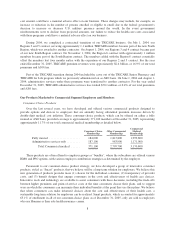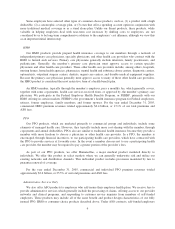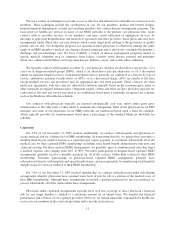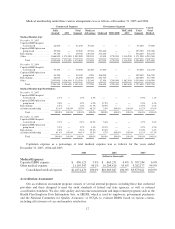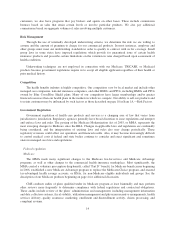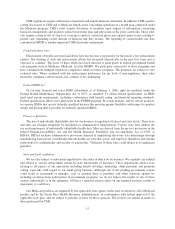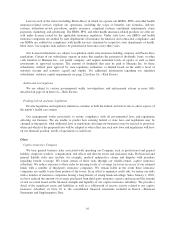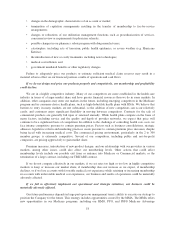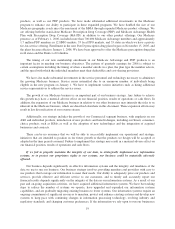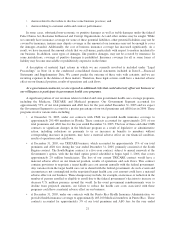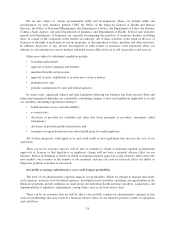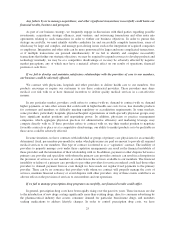Humana 2005 Annual Report Download - page 28
Download and view the complete annual report
Please find page 28 of the 2005 Humana annual report below. You can navigate through the pages in the report by either clicking on the pages listed below, or by using the keyword search tool below to find specific information within the annual report.• changes in the demographic characteristics of an account or market;
• termination of capitation arrangements resulting in the transfer of membership to fee-for-service
arrangements;
• changes or reductions of our utilization management functions such as preauthorization of services,
concurrent review or requirements for physician referrals;
• possible changes in our pharmacy rebate program with drug manufacturers;
• catastrophes, including acts of terrorism, public health epidemics, or severe weather (e.g. Hurricane
Katrina);
• the introduction of new or costly treatments, including new technologies;
• medical cost inflation; and
• government mandated benefits or other regulatory changes.
Failure to adequately price our products or estimate sufficient medical claim reserves may result in a
material adverse effect on our financial position, results of operations and cash flows.
If we do not design and price our products properly and competitively, our membership and profitability
could decline.
We are in a highly competitive industry. Many of our competitors are more established in the health care
industry in terms of a larger market share and have greater financial resources than we do in some markets. In
addition, other companies may enter our markets in the future, including emerging competitors in the Medicare
program and in consumer-choice health plans, such as high deductible health plans with HSAs. We believe that
barriers to entry in many markets are not substantial, so the addition of new competitors can occur relatively
easily, and customers enjoy significant flexibility in moving between competitors. Contracts for the sale of
commercial products are generally bid upon or renewed annually. While health plans compete on the basis of
many factors, including service and the quality and depth of provider networks, we expect that price will
continue to be a significant basis of competition. In addition to the challenge of controlling health care costs, we
face intense competitive pressure to contain premium prices. Factors such as business consolidations, strategic
alliances, legislative reform and marketing practices create pressure to contain premium price increases, despite
being faced with increasing medical costs. The commercial pricing environment, particularly in the 2 to 300
member groups, is extremely competitive. Several of our competitors, including public and not-for-profit
companies, are pricing aggressively to gain market share.
Premium increases, introduction of new product designs, and our relationship with our providers in various
markets, among other issues, could also affect our membership levels. Other actions that could affect
membership levels include our possible exit from or entrance into Medicare or Commercial markets, or the
termination of a large contract, including our TRICARE contract.
If we do not compete effectively in our markets, if we set rates too high or too low in highly competitive
markets to keep or increase our market share, if membership does not increase as we expect, if membership
declines, or if we lose accounts with favorable medical cost experience while retaining or increasing membership
in accounts with unfavorable medical cost experience, our business and results of operations could be materially
adversely affected.
If we fail to effectively implement our operational and strategic initiatives, our business could be
materially adversely affected.
Our future performance depends in large part upon our management team’s ability to execute our strategy to
position the Company for the future. This strategy includes opportunities created by the MMA. The MMA offers
new opportunities in our Medicare programs, including our HMO, PPO, and PFFS Medicare Advantage
18


